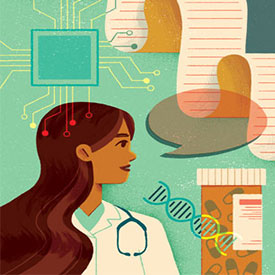 Maybe the flying cars we were promised haven’t materialized yet, but 21st-century life is still a marvel in many ways. And that certainly includes medicine and health care, where technological innovations have wrought stunning transformations in the 50 years since the University of Alabama at Birmingham was officially established.
Maybe the flying cars we were promised haven’t materialized yet, but 21st-century life is still a marvel in many ways. And that certainly includes medicine and health care, where technological innovations have wrought stunning transformations in the 50 years since the University of Alabama at Birmingham was officially established.
So what does the future hold, in terms of both the practice of medicine and the challenges facing the overall health care system? Considering how much has changed over the past half century, the possibilities are exhilarating.
We asked seven UAB experts to predict what may lie ahead for the practice of medicine, health care delivery, medical training, and biomedical research as UAB Medicine embarks on its next 50 years.
Tech Storm
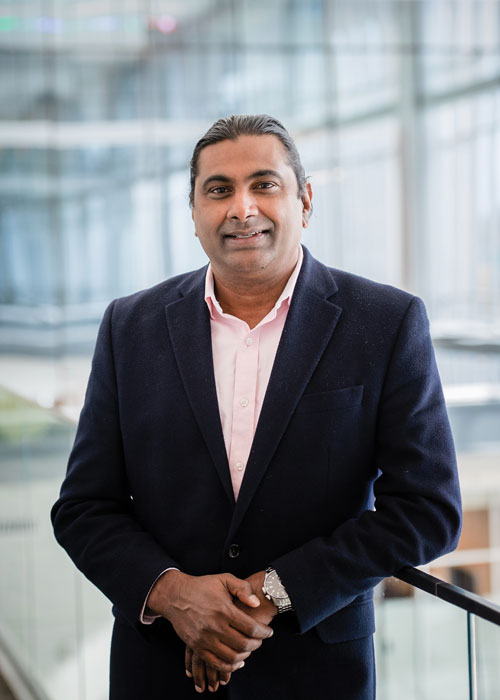 Rubin Pillay“Technology is poised to transform health care across the world,” says Rubin Pillay, Ph.D., M.D., MBA, assistant dean for global health innovation in the School of Medicine. “It has the potential to turn unsustainable health care systems into sustainable ones; equalize the relationship between medical professionals and patients; and provide cheaper, faster, and more effective solutions for diseases.”
Rubin Pillay“Technology is poised to transform health care across the world,” says Rubin Pillay, Ph.D., M.D., MBA, assistant dean for global health innovation in the School of Medicine. “It has the potential to turn unsustainable health care systems into sustainable ones; equalize the relationship between medical professionals and patients; and provide cheaper, faster, and more effective solutions for diseases.”
Pillay says technology advances can help solve many of the most serious challenges facing health care, including struggling rural hospitals, physician shortages, and an overburdened system. “We are destined for a future of near perfect health,” he optimistically declares.
Pillay, author of a book about the future of medicine titled Healthcare 3.0: How Technology Is Driving the Transition to Prosumers, Platforms, and Outsurance, says technology will propel several major trends that will “see health care flipped on its head.” Some of these include people producing their own health care services (similar to the way they manage banking services through technology), and companies increasing telehealth technology and new care-delivery options (similar to the way Uber transformed the transportation industry).
“Despite significant advances in the biomedical sciences and health care, we are barraged with negative news. This constant onslaught often distorts our perspective on the future,” Pillay says. “But the good news is we are on the cusp of radical change.
“The future will be the result of exponential growth among advanced technologies like digital medicine, artificial intelligence, gene editing, nanotechnology, robotics; the list goes on. This technological storm will transform medicine and health care in ways that sounded like science fiction a mere decade ago.”
New Approaches in Delivery
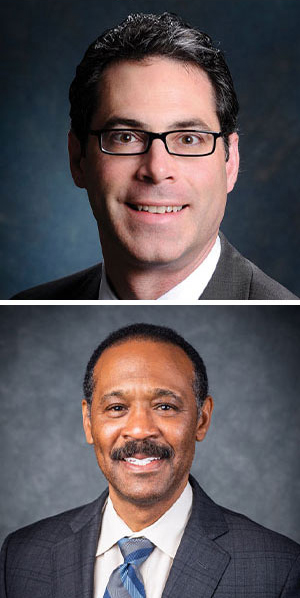 Top to bottom: David Randall and Tony Jones.David Randall, MBA, senior vice president for strategy and business development for UAB Health System, foresees a time when using Apple each day will keep the doctor away. He notes that computer technology will provide reliable health care information and services, allowing patients to bypass some traditional barriers.
Top to bottom: David Randall and Tony Jones.David Randall, MBA, senior vice president for strategy and business development for UAB Health System, foresees a time when using Apple each day will keep the doctor away. He notes that computer technology will provide reliable health care information and services, allowing patients to bypass some traditional barriers.
“We’re going to see significant disruption in the health care marketplace from a number of nontraditional providers in areas of access, convenience, and the whole patient-engagement platform,” Randall says. “The biggest impact is going to come from the Big Five: Apple, Amazon, Google, Facebook, and Microsoft. They’re going to transition knowledge that was exclusive to traditional health care providers and put it directly into the hands of consumers.”
Randall says some apps allow phones to conduct ultrasounds or create EKG readouts, and devices’ medical possibilities will increase. He says technology will make it easier for patients to communicate with their health care providers.
“Right now, friction exists between consumers and providers, like the ability to schedule a doctor’s appointment online or have ongoing communication with your provider after your scheduled appointment,” Randall says. “These new technologies will minimize those friction points.”
This technology works both ways, as traditional providers will use telemedicine to reach patients who have difficulty traveling to a doctor’s office or hospital. This will help alleviate some health inequities currently caused by financial status or location, particularly for patients in rural areas.
“We’re investing heavily in telemedicine to provide various points of access and engagement that can meet patients’ demands,” Randall says. “We have to create more contact points, utilizing partnerships as a basis to increase our reach.”
Tony Jones, M.D., UAB Health System’s chief physician executive, University of Alabama Health Services Foundation president, and senior associate dean for clinical affairs in the SOM, says health care will become even more team-based in the coming years, as advanced practice providers (APP) such as nurse practitioners and physician assistants work more directly with physicians in examining and treating patients.
“There already aren’t enough physicians to provide access-to-care to all our populations that need it, and the demand will increase in the future,” Jones says. “Transitioning to a team approach is absolutely essential, where it’s led by the physician and includes an APP, care manager, social worker, nutritionist, or RN.
“The care managers will identify the most complex patients and routinely engage them in their home environments. They’ll contact them two or three times a week, making sure they’re taking their medications correctly and answering any questions. That reduces the need for patients to come in for a clinical visit.”
On the administration side, health care workers will use the team approach more successfully, Jones says, eliminating many time-consuming tasks that currently plague providers such as coding and billing, electronic health record documentation, and care coordination.
“New technologies should be used to relieve providers of the administrative burdens to delivering care,” Jones says. “This will allow the physician to focus on the patient and provide more access to new patients seeking the unique clinical expertise of our providers.”
Training for Tomorrow
Craig Hoesley, M.D., senior associate dean for medical education in the School of Medicine, says there was a basic pattern to medical education throughout the 20th century. The first two years emphasized learning and understanding the foundational sciences, and the final two years focused on applying that information to patient care. But that formula isn’t sustainable throughout the 21st century.
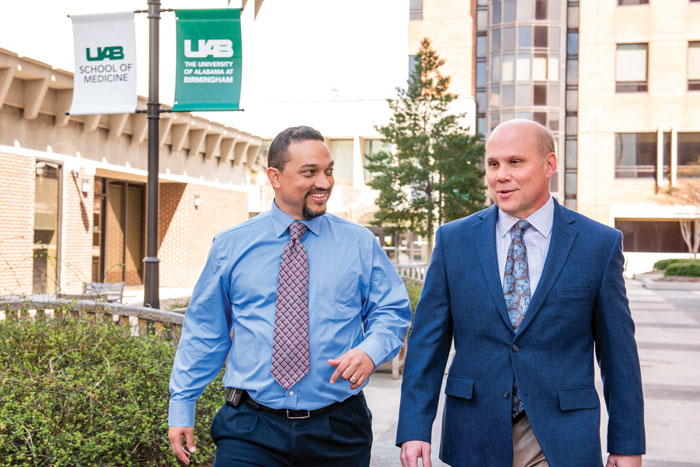 Left to right: James Willig and Craig Hoesley.“The way we train doctors is going to change dramatically,” Hoesley says. “It’s going to become more competency-based for all the health professions. We’ll have a uniform understanding and agreement on what the competency should be, and a general outline of when those competencies should be met. But the amount time in medical school will really come down to how you meet the competencies.
Left to right: James Willig and Craig Hoesley.“The way we train doctors is going to change dramatically,” Hoesley says. “It’s going to become more competency-based for all the health professions. We’ll have a uniform understanding and agreement on what the competency should be, and a general outline of when those competencies should be met. But the amount time in medical school will really come down to how you meet the competencies.
“For some students it may not take four years, and for others it may take a little longer. When you meet the competencies, you move forward in your training,” Hoesley says. “It has the potential to shorten medical training and residencies. And that’s important when you think about the projected physician shortage. It will allow us to train more physicians more efficiently and get them out in practice quicker. I think there’s growing support for that model.”
Hoesley also predicts that medical training will become even more team-focused. “They will have to constantly work with numerous health care professionals, so the team approach is quickly becoming a medical education staple.
“The physician will be only one part of how we take care of patients—nurses will play a significant role, along with social workers, pharmacists, and others,” Hoesley says. “In training medical students, there will be much more of an emphasis on interprofessional education—teaching them how to work with a team. Shared curricula across the health professions schools is going to become increasingly common and a standard requirement for accreditation.
“In terms of curriculum, lectures will become less dominant. It will become more team-oriented, problem-based learning. Physicians will need to develop clinical reasoning and problem-solving skills while in school. That’s what they’ll spend their careers doing, so the whole curriculum will shift in that direction.”
James Willig, M.D., MSPH, assistant dean for clinical education, agrees that massive changes are coming to medical education and care, but he insists some aspects of the profession are immutable. “There’s an old maxim, ‘A physician is a combination of skills, knowledge, and attitude,’ and all three must be developed,” he says. “In terms of knowledge, the biggest looming change is precision medicine. The easy access to genetic information in unprecedented quantity at the point of care will change the way we approach disease. We’ll be able to leverage genetic insights from the host as well as attack pathogens, tumors, etc., to personalize and optimize therapeutic choices. Clinicians on the front lines of care will have to integrate these data into their practice. It will spark conversations with patients that we don’t have today—individuals’ own future risk of illness and their family’s risk of illness. As these data become ubiquitous and available, these conversations will move to the primary care arena as opposed to going to those with specialized training in genetics.
“The other big influence is new technologies. As more computational power becomes available, what is the role of virtual reality simulations in the process of care? Will we be able to use virtual reality experiences to explain how a surgery will unfold or how a connective tissue disease is harming a joint? How can we best leverage electronic data? Will we use artificial intelligence, machine learning, advances in natural language processing, or other new technologies to highlight key decision-making pieces of the ocean of available data at the right time—at the point of care—to maximize patient benefit? Those are going to be some interesting questions to deal with in terms of how we integrate all these newer data streams and technologies into the point of care to create new knowledge that benefits those we serve.
“We’re also going to benefit from data captured outside the hospital—in terms of monitoring devices/sensors and in-phone apps—to track all kinds of health outcomes,” continues Willig. “I envision a future where you’ll walk into a restaurant, and your phone will use your location to access the restaurant’s menu online. It will take into account your medical history and recommend your optimal eating options, which might lead to making more healthy choices. That will be a way for physicians to be present and provide support between a patient’s visits. We’ll help people as they go through day-to-day decision making, rather than just seeing them every few months in the clinic.”
At the same time, Willig says the abundance of technological advances will make some traditional aspects of the profession even more critical. “What may become an even greater challenge for us is how we continue to emphasize the humanistic and empathetic part of medicine,” he notes.
“While there will be great advances in quantitative diagnosis and therapeutics for our patients improving our skills and knowledge, how do we continue to teach physicians to be humane and empathetic and available emotionally at the bedside to those in need and their families? That challenge will grow in an age of very technically attuned physicians who have much more quantitative data to rely on than previous generations, but one thing that will probably not change is that we’ll never have a cure for everything.
“Ultimately, the enduring challenge is for us to be there for patients and families—to be empathetic and emotionally available to those in need and to develop not just as professionals but as people,” concludes Willig. “And when we don’t have a cure to offer, we need to offer comfort and support in difficult times. That is an enduring principle that will be with us always.”
The Silver Tsunami
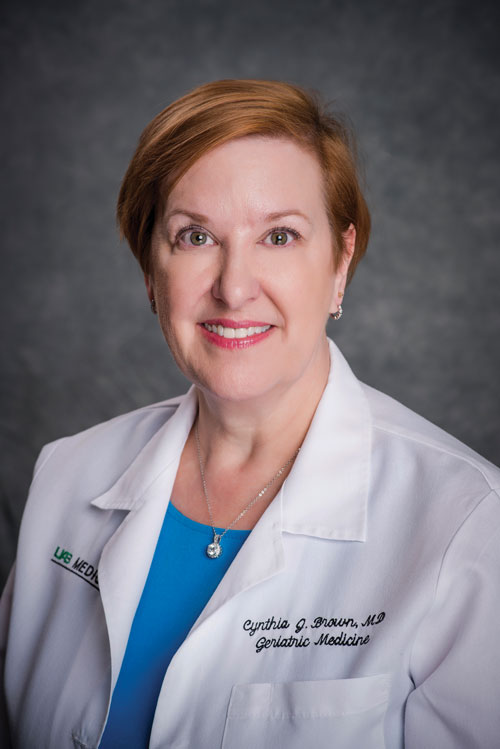 Cynthia BrownFor decades, there have been warnings about an impending health care crisis in the U.S. associated with the aging baby boomer generation. Over the next two decades, those warnings are poised to become reality, as an average of approximately 10,000 people each day will reach age 65. By the year 2030, one-fifth of the nation will be older than 65.
Cynthia BrownFor decades, there have been warnings about an impending health care crisis in the U.S. associated with the aging baby boomer generation. Over the next two decades, those warnings are poised to become reality, as an average of approximately 10,000 people each day will reach age 65. By the year 2030, one-fifth of the nation will be older than 65.
“With that is going to come a real shift in how we think about older adults,” says Cynthia Brown, M.D., director of the UAB Division of Gerontology, Geriatrics, and Palliative Care. “We’re going to have to start thinking out of the box about how we do business in taking care of this large volume of older adults, because the number of people is going to be incredible.”
Leading the way in this changing approach will be the older adults themselves, who Brown says will be unwilling to passively live out their days in a retirement facility. Instead, they want to remain physically active and engaged for as long as possible, requiring an increase in medical professionals and services geared toward older adults.
“The baby boomers have been better about exercising, eating well, and staying active, and they’re going to want to do that well into their 80s,” Brown says. “They’re not going to be content to sit around and let their bodies fall apart.”
Brown says she believes this aging future will result in a return to a medical practice from the past: house calls.
“We’re going to see a shift away from hospitals and toward delivering care in the home,” Brown says. “It’s less expensive to provide care in the home, and we’re going to improve our ability to manage that. Plus, it’s preferable to handle certain diseases like pneumonia in the home, so we’ll create systems that don’t require a hospital.”
From Cutting-Edge to Routine Care
Even though the Hugh Kaul Precision Medicine Institute at UAB is only a few years old, Director Matt Might, Ph.D., says the facility eventually will need a new name. “In 20 years, we won’t call it precision medicine; it will just be medicine,” he says. “By then, all medicine will be precision medicine.”
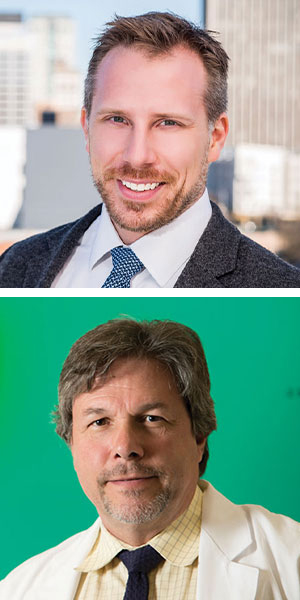 Top to bottom: Matt Might and James Cimino.This data-driven process—which tailors treatment for the specific patient rather than for the disease—will steadily expand as more is revealed by genomic research and is combined with reams of health data gathered through electronic medical records and other sources (including social media).
Top to bottom: Matt Might and James Cimino.This data-driven process—which tailors treatment for the specific patient rather than for the disease—will steadily expand as more is revealed by genomic research and is combined with reams of health data gathered through electronic medical records and other sources (including social media).
“A general practitioner will have the ability to look at tremendous amounts of data on a patient and optimize treatment based on that data,” Might says. “Every patient has options that work for them but maybe not for everybody else, and the ability to identify those options is improving. What we’ll end up with is truly personalized, truly tailored care, where the pill you take for your heart disease might not work for anybody else. But it works for you.”
Unlocking genomic data is only the first step, Might says. Data will be obtained from a variety of molecules, chemicals, and proteins throughout the body. Combined, this data will enable physicians to predict the potential development of diseases and start the patient on preventive treatment.
“Every human being will end up with their own individual baseline across all of these data-collection modalities,” Might says. “The more of these that we make clinically accessible, the more precise we can be in how we treat. We’ll be able to sense early on when you’re deviating from normal and prescribe very precise interventions based on that. The possibilities are really exciting.”
Of course, having access to all this information doesn’t mean much if you’re unable to analyze it correctly. In the coming decades, entities such as the UAB Informatics Institute will help researchers and physicians glean useful information from an ever-growing ocean of data.
“We have to figure out that last three feet of the process—the distance between the computer and the patient—to ensure that clinicians and caregivers can use information to make good decisions for their patients,” James Cimino, M.D., director of the UAB Informatics Institute, says. “Just filling computers with information about human health and disease is not going to make mankind better. We have to bring it to bear on patient care.”
Cimino says the process of analyzing data will become easier as the amount of data increases. He notes that genomic research based on analysis of EHR data is in its early stages.
“Right now, we don’t have enough data for our systems to look for correlations, so we can’t do much in an automated way. We have to use manual methods that are inefficient and slow,” Cimino says. “It’s hard to pick out relevant information without being overwhelmed by the irrelevant information. But as the quality and volume of those data go up, the ability to automate things is certainly going to progress. There are all kinds of difficulties right now related to the incompleteness and inaccuracy of the data, but we’re on a path to be in a much better place 10 years from now.”
Eventually, Cimino says, data analytics will advance to a point that it can be used to inform a patient’s care throughout their life. “It will make sense to sequence everybody at birth and have that record follow them around their entire life,” Cimino says. “We’ll have that data set to work from, which will be more comprehensive and accurate, and result in better quality care.”
Research Frontiers
For all the knowledge we have gained about human biology, there is one area of the body that is yet to be fully understood. The brain has been called one of the last unexplored frontiers in science, and, according to Etty (Tika) Benveniste, Ph.D., senior vice dean of basic sciences in the School of Medicine, the future of research will involve unraveling its mysteries.
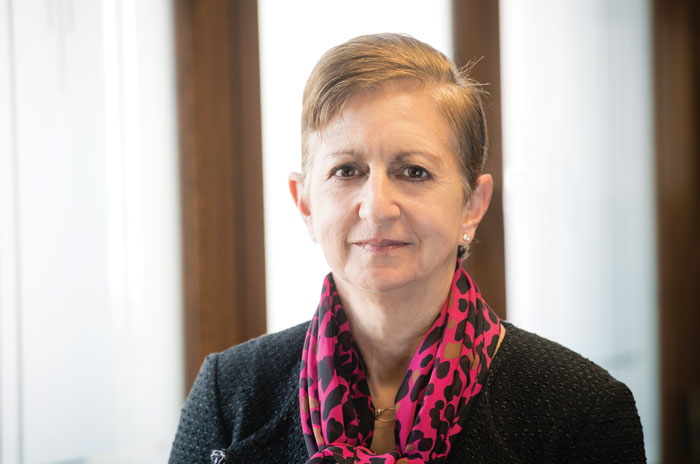 Etty (Tika) Benveniste“The brain is an organ just like the kidney and the liver, but it is so much more complex,” she says. “The circuitries that drive neuronal activity are still being worked out. There’s still a lot we don’t understand about normal neurological development and what goes wrong during neuro development in a disease like autism. There’s still so much fundamental basic knowledge that we need to acquire to really understand how the brain develops, and what the changes in the brain are during aging that lead to Alzheimer’s and Parkinson’s.”
Etty (Tika) Benveniste“The brain is an organ just like the kidney and the liver, but it is so much more complex,” she says. “The circuitries that drive neuronal activity are still being worked out. There’s still a lot we don’t understand about normal neurological development and what goes wrong during neuro development in a disease like autism. There’s still so much fundamental basic knowledge that we need to acquire to really understand how the brain develops, and what the changes in the brain are during aging that lead to Alzheimer’s and Parkinson’s.”
Benveniste says we are already on the path of many of the most fruitful avenues of exploration that will transform treatment for a range of diseases in the future. “The School of Medicine really excels in the area of fundamental immunology,” she says. “We have many investigators who are working to better understand the normal functions of immune cells and what goes wrong with those immune cells in a variety of diseases including autoimmune diseases, neuroinflammatory diseases, and cancer. The quest to understand how the normal functioning of immune cells is subverted in a variety of disease states will provide opportunities for therapeutic targeting to reprogram those cells and restore their normal functions.
“For example, we have known for decades the importance of neuroinflammation in multiple sclerosis (MS), and all the therapeutic interventions in MS are directed at altering the functionality of those immune cells,” she says. “What is new and exciting—and an area that the School of Medicine’s research will pursue in the coming decades—is the role of neuroinflammation in other diseases, especially neurodegenerative diseases such as Alzheimer’s, Parkinson’s, and ALS, and neurodevelopmental diseases such as autism. It may even play a role in psychiatric disorders such as schizophrenia and depression.
“Understanding how the function of immune cells changes when they are in the microenvironment of the brain will allow us to understand how they contribute to neuroinflammation. Ultimately what you get is significant neuronal destruction, which is a hallmark of the diseases I mentioned. With that understanding, we can start to identify better therapeutic targets for those diseases. There currently is very little that can be done for patients with Alzheimer’s, Parkinson’s, ALS, and autism, but hopefully research discoveries in the coming decades will change that.”
By Cary Estes